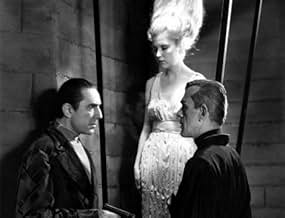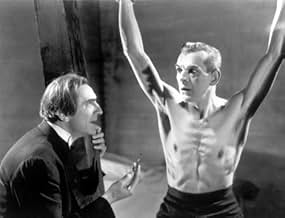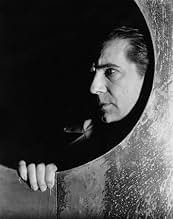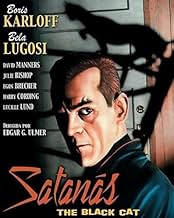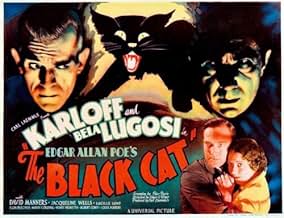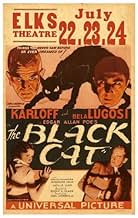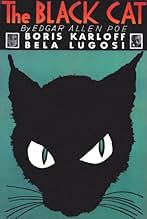Unos recién casados estadounidenses en Hungría quedan atrapados en la casa de un sacerdote adorador de Satanás cuando la novia es llevada allí para recibir ayuda médica después de un accid... Leer todoUnos recién casados estadounidenses en Hungría quedan atrapados en la casa de un sacerdote adorador de Satanás cuando la novia es llevada allí para recibir ayuda médica después de un accidente de tráfico.Unos recién casados estadounidenses en Hungría quedan atrapados en la casa de un sacerdote adorador de Satanás cuando la novia es llevada allí para recibir ayuda médica después de un accidente de tráfico.
- Dirección
- Guionistas
- Elenco
- Premios
- 2 premios ganados y 1 nominación en total
Boris Karloff
- Hjalmar Poelzig
- (as Karloff)
Julie Bishop
- Joan Alison
- (as Jacqueline Wells)
Virginia Ainsworth
- Cultist
- (sin créditos)
Luis Alberni
- Train Steward
- (sin créditos)
King Baggot
- Cultist
- (sin créditos)
Herman Bing
- Car Steward
- (sin créditos)
Symona Boniface
- Cultist
- (sin créditos)
John Carradine
- Cult Organist
- (sin créditos)
André Cheron
- Train Conductor
- (sin créditos)
George Davis
- Bus driver
- (sin créditos)
Andy Devine
- Bit Part
- (sin créditos)
Opiniones destacadas
I won't comment about the acting or plot -- there's plenty of that here already. What I'd rather do is call attention to the visuals -- the cinematography, lighting, costuming, and especially the set design.
Normally, horror films take place in ancient settings -- crude medieval fortresses and rustic castles that are dark, cluttered and gloomy. But this one is set in a perversely utopian sci-fi fantasy -- the clean lined, impeccably detailed, generously glazed modernistic and (usually) radiantly lit white-and-silver upper floor interiors of the house.
The lower floor is an expressionistic prison, also clean lined, but still dungeon-like with its windowless walls of exposed board-formed concrete. An elegant steel spiral staircase connects the two, and the angular expressionism reaches its culmination in the chamber used for the black mass.
Karloff's costumes recall Oskar Schemmer's Bauhaus-produced work -- angular, broad-shouldered, narrow-waisted and elegant. Even the haircut of this man of the future in sharp and angular. His character is an engineer and architect and is given the name -- Poelzig -- of a famous expressionist German architect and film set designer of the time, who was a colleague of the director on an earlier film. The elegant futurism in carried down to the detail level, including a digital night-table clock and an abstract chess set. Much of the genius of this movie is that it breaks the horror-movie visual mold, and floods it with light, creating a fascinating tension between plot and setting.
Normally, horror films take place in ancient settings -- crude medieval fortresses and rustic castles that are dark, cluttered and gloomy. But this one is set in a perversely utopian sci-fi fantasy -- the clean lined, impeccably detailed, generously glazed modernistic and (usually) radiantly lit white-and-silver upper floor interiors of the house.
The lower floor is an expressionistic prison, also clean lined, but still dungeon-like with its windowless walls of exposed board-formed concrete. An elegant steel spiral staircase connects the two, and the angular expressionism reaches its culmination in the chamber used for the black mass.
Karloff's costumes recall Oskar Schemmer's Bauhaus-produced work -- angular, broad-shouldered, narrow-waisted and elegant. Even the haircut of this man of the future in sharp and angular. His character is an engineer and architect and is given the name -- Poelzig -- of a famous expressionist German architect and film set designer of the time, who was a colleague of the director on an earlier film. The elegant futurism in carried down to the detail level, including a digital night-table clock and an abstract chess set. Much of the genius of this movie is that it breaks the horror-movie visual mold, and floods it with light, creating a fascinating tension between plot and setting.
I can't imaging how this movie would have been without both Bela Lugosi and Boris Karloff, probably very very bad. The chemistry between the two is amazing.
This is one of those movies in which the story absolutely doesn't matter. The story is totally absurd and very simple (The black cat storyline has absolutely nothing to do with the movie and serves no purpose at all) but yet that is what maybe makes this movie extremely fun and easy to watch.
Watching this movie made me realize something; Bela Lugosi actually was a very good actor that was ahead of his time. The way he delivers his lines and his eye for details shows that acting was a great passion for him. Yes I think I can now be considered one of his fans.
Another great thing were the sets that were wonderful and even now 70 years later they still look very modern.
Don't expect a movie with ghouls and monsters, it rather is more fun to watch then it is scary and the Lugosi/Karloff combination is what makes this movie a real classic.
7/10
http://bobafett1138.blogspot.com/
This is one of those movies in which the story absolutely doesn't matter. The story is totally absurd and very simple (The black cat storyline has absolutely nothing to do with the movie and serves no purpose at all) but yet that is what maybe makes this movie extremely fun and easy to watch.
Watching this movie made me realize something; Bela Lugosi actually was a very good actor that was ahead of his time. The way he delivers his lines and his eye for details shows that acting was a great passion for him. Yes I think I can now be considered one of his fans.
Another great thing were the sets that were wonderful and even now 70 years later they still look very modern.
Don't expect a movie with ghouls and monsters, it rather is more fun to watch then it is scary and the Lugosi/Karloff combination is what makes this movie a real classic.
7/10
http://bobafett1138.blogspot.com/
Travelling across Eastern Europe, Peter and Joan Allison meet Dr Werdegast on the train. When the bus taking them to their destination crashes, the Allisons go with Werdegast and stay with him at the foreboding castle of Hjalmar Poelzig. However the Allisons find themselves in danger when it becomes apparent that Werdegast and Poelzig have a deadly history with each other.
Although it carries the title of his book and a credit for him on the titles, this film has little to do with Poe's work. In fact, in terms of plotting, it owes very little to anybody because, aside from the actual set up, the plot just goes all to hell very quickly. The set up is interesting and I wanted to know more about the history between these two men, then there is the thing about the black cat and Werdegast, not to mention the fact that Poelzig seems to be very interested in reading about satanic cults! However, none of this is really fully explained - this is partly due to the short run time and so much material, but it must also be blamed on the film not having a strong focus other than atmosphere.
The film still works well as the plot crumbles, but it is a little unsatisfying as it leaves so many half stories and unanswered questions. What it does do well though is atmosphere, the direction is cheap but effective and the lighting works wonders in a cheap set! The cast also contribute to this focus on atmosphere (or style) over plot (or substance). Karloff overdoes things, but he overdoes them very well! There is no real need for him to be as ominous as he is at the start but it is what we have come to expect from him. Lugosi may have tarnished his reputation towards the end of his career, but he is good here. It's hard not to laugh when seeing him convulsed with fear over the cat but he plays it well for the most part. Manners and Wells are both OK but are very much the onscreen representation of the audience and simply have to act shocked by everything and run away lots!
Overall this is a good film but only because of the atmosphere and the influence of two legendary stars in the cast. The plot had potential but not enough time is allowed for it to be explored and the focus is more on the atmosphere than the construction.
Although it carries the title of his book and a credit for him on the titles, this film has little to do with Poe's work. In fact, in terms of plotting, it owes very little to anybody because, aside from the actual set up, the plot just goes all to hell very quickly. The set up is interesting and I wanted to know more about the history between these two men, then there is the thing about the black cat and Werdegast, not to mention the fact that Poelzig seems to be very interested in reading about satanic cults! However, none of this is really fully explained - this is partly due to the short run time and so much material, but it must also be blamed on the film not having a strong focus other than atmosphere.
The film still works well as the plot crumbles, but it is a little unsatisfying as it leaves so many half stories and unanswered questions. What it does do well though is atmosphere, the direction is cheap but effective and the lighting works wonders in a cheap set! The cast also contribute to this focus on atmosphere (or style) over plot (or substance). Karloff overdoes things, but he overdoes them very well! There is no real need for him to be as ominous as he is at the start but it is what we have come to expect from him. Lugosi may have tarnished his reputation towards the end of his career, but he is good here. It's hard not to laugh when seeing him convulsed with fear over the cat but he plays it well for the most part. Manners and Wells are both OK but are very much the onscreen representation of the audience and simply have to act shocked by everything and run away lots!
Overall this is a good film but only because of the atmosphere and the influence of two legendary stars in the cast. The plot had potential but not enough time is allowed for it to be explored and the focus is more on the atmosphere than the construction.
THE BLACK CAT (1934) Starring Boris Karloff, Bela Lugosi, David Manners, Julie Bishop Directed by Edgar Ulmer
The first film to feature both Boris Karloff and Bela Lugosi, THE BLACK CAT was, and remains, innovative and strange. The opening credits claim the film was "suggested by" the Edgar Alan Poe story, but other than the title there is absolutely no connection.
Lugosi gets to play a good guy for a change and he handles it very well. In fact, I might venture to say that the role of Dr. Vitus Werdegast is Lugosi's finest performance, perhaps because it is so much of a departure from the role of Dracula. Karloff plays Hjalmar Poelzig, a Satanic architect with a really freaky hairdo. David Manners and Julie Bishop portray the Allisons, an American couple honeymooning in Hungary (doesn't everyone?).
The real star of this film, though, is the house. What an incredible set! The house, designed and built by Poelzig on the ruins of a WWI fort where thousands of soldiers are entombed, is an architectural marvel, even by today's standards. All glass and steel, the house consists of sharp angles that cast long, expressionistic shadows, which gives the film its extremely creepy atmosphere.
Werdegast (Lugosi) meets the Allisons on a train and later shares a cab with them. As they drive through a storm, he explains that he is going to visit an old friend after having spent 15 years as a prisoner of war. Not far from his friend's house the cab crashes, killing the driver and injuring Mrs. Allison. They carry her to Werdegast's friend's house. The friend, of course, is Poelzig (Karloff) and it soon becomes obvious that the term "friend" is applied very loosely. In fact, the men have become enemies due to the fact that Poelzig betrayed Werdegast during the war, which led to his long imprisonment. In the basement, Poelzig reunites Werdegast with his wife, now dead and whom Poelzig had married himself while Werdegast was in prison. The freaky architect has been keeping her preserved in some sort of suspended animation type thing. When Werdegast demands to know his daughter's whereabouts, Poelzig tells him that she, too, has died.
What follows is a bizarre tale of two men who are opposite sides of the coin. They engage in a chess match (literally and figuratively) with the soul of the injured Mrs. Allison up for grabs. THE BLACK CAT is incredibly creepy and has some real suspenseful moments. It also has some very disturbing scenes, especially for a film made in 1934. The scene of Karloff reciting the black mass in Latin is especially ominous. One cannot, however, help noticing some gaping holes in the plot. Dr. Werdegast is supposed to be Hungary's leading doctors, and yet he has just been released from 15 years of imprisonment. Huh? Also, there is a cruel scene where Lugosi's character kills a black cat (he has a phobia) and nobody seems to think anything about it...even though it appears to have been a pet in the household. These minor points do not take away from the overall viewing experience, though. THE BLACK CAT still looks great after all these years and it still has the ability to make you shudder.
The first film to feature both Boris Karloff and Bela Lugosi, THE BLACK CAT was, and remains, innovative and strange. The opening credits claim the film was "suggested by" the Edgar Alan Poe story, but other than the title there is absolutely no connection.
Lugosi gets to play a good guy for a change and he handles it very well. In fact, I might venture to say that the role of Dr. Vitus Werdegast is Lugosi's finest performance, perhaps because it is so much of a departure from the role of Dracula. Karloff plays Hjalmar Poelzig, a Satanic architect with a really freaky hairdo. David Manners and Julie Bishop portray the Allisons, an American couple honeymooning in Hungary (doesn't everyone?).
The real star of this film, though, is the house. What an incredible set! The house, designed and built by Poelzig on the ruins of a WWI fort where thousands of soldiers are entombed, is an architectural marvel, even by today's standards. All glass and steel, the house consists of sharp angles that cast long, expressionistic shadows, which gives the film its extremely creepy atmosphere.
Werdegast (Lugosi) meets the Allisons on a train and later shares a cab with them. As they drive through a storm, he explains that he is going to visit an old friend after having spent 15 years as a prisoner of war. Not far from his friend's house the cab crashes, killing the driver and injuring Mrs. Allison. They carry her to Werdegast's friend's house. The friend, of course, is Poelzig (Karloff) and it soon becomes obvious that the term "friend" is applied very loosely. In fact, the men have become enemies due to the fact that Poelzig betrayed Werdegast during the war, which led to his long imprisonment. In the basement, Poelzig reunites Werdegast with his wife, now dead and whom Poelzig had married himself while Werdegast was in prison. The freaky architect has been keeping her preserved in some sort of suspended animation type thing. When Werdegast demands to know his daughter's whereabouts, Poelzig tells him that she, too, has died.
What follows is a bizarre tale of two men who are opposite sides of the coin. They engage in a chess match (literally and figuratively) with the soul of the injured Mrs. Allison up for grabs. THE BLACK CAT is incredibly creepy and has some real suspenseful moments. It also has some very disturbing scenes, especially for a film made in 1934. The scene of Karloff reciting the black mass in Latin is especially ominous. One cannot, however, help noticing some gaping holes in the plot. Dr. Werdegast is supposed to be Hungary's leading doctors, and yet he has just been released from 15 years of imprisonment. Huh? Also, there is a cruel scene where Lugosi's character kills a black cat (he has a phobia) and nobody seems to think anything about it...even though it appears to have been a pet in the household. These minor points do not take away from the overall viewing experience, though. THE BLACK CAT still looks great after all these years and it still has the ability to make you shudder.
Other commentaries will fill you in on the nearly-incomprehensible plot (if that's possible) but, as has been pointed out, you don't watch a film like this for plot.
Despite the story inconsistencies and implausibilities, everything here just seems to "jell:" the fabulous sets, elegant photography, evocative music (drawing heavily from Schubert, among others) and the downright creepy atmosphere woven from the themes of jealousy, lust, revenge, murder, sadism.....all sounds delightfully sick, doesn't it? Truly, it's nowhere near as threatening as it sounds; indeed, if Astaire and Rogers had ever made a spooky thriller, it might have looked and felt something like this one. THE BLACK CAT possesses a lyrical, rhythmic quality, upon which we drift through a sleek, ultra-modern nightmare world.
One of the reasons it all works is its ability to pull us into a sort of parallel universe which, though it looks more or less like reality as we know it, glides along on a barely-concealed undercurrent - an "atmosphere of death," as Lugosi's character puts it - where things happen that "could never actually happen" (an inside reference for those who know the film).
There are some wonderful set-pieces, such as Karloff's tour through a most unusual basement mausoleum/museum memorializing all of his dearly departed earlier "wives." And of course, Boris and Bela deliver, with their restrained but full-bodied performances. Karloff conveys menace just entering a room, and Lugosi has an all-too-rare opportunity to display some tenderness; notice the single tear that rolls down his face as he learns - and sees - what became of the wife that Karloff stole from him years before.
A very stylized - and stylish - film which grants us the unusual treat of seeing Lugosi play a (more or less) "good guy," and the unique one of hearing him pronounce the word "baloney," as only he could.
Despite the story inconsistencies and implausibilities, everything here just seems to "jell:" the fabulous sets, elegant photography, evocative music (drawing heavily from Schubert, among others) and the downright creepy atmosphere woven from the themes of jealousy, lust, revenge, murder, sadism.....all sounds delightfully sick, doesn't it? Truly, it's nowhere near as threatening as it sounds; indeed, if Astaire and Rogers had ever made a spooky thriller, it might have looked and felt something like this one. THE BLACK CAT possesses a lyrical, rhythmic quality, upon which we drift through a sleek, ultra-modern nightmare world.
One of the reasons it all works is its ability to pull us into a sort of parallel universe which, though it looks more or less like reality as we know it, glides along on a barely-concealed undercurrent - an "atmosphere of death," as Lugosi's character puts it - where things happen that "could never actually happen" (an inside reference for those who know the film).
There are some wonderful set-pieces, such as Karloff's tour through a most unusual basement mausoleum/museum memorializing all of his dearly departed earlier "wives." And of course, Boris and Bela deliver, with their restrained but full-bodied performances. Karloff conveys menace just entering a room, and Lugosi has an all-too-rare opportunity to display some tenderness; notice the single tear that rolls down his face as he learns - and sees - what became of the wife that Karloff stole from him years before.
A very stylized - and stylish - film which grants us the unusual treat of seeing Lugosi play a (more or less) "good guy," and the unique one of hearing him pronounce the word "baloney," as only he could.
¿Sabías que…?
- TriviaAmong the unconventional elements of this film was the soundtrack. At a time (early 1930s) when movie music was usually limited to the titles and credits, Edgar G. Ulmer had an almost continuous background score throughout the entire film.
- ErroresVitus identifies Kurgaal as being "near Omsk, by Lake Baikal." In reality Omsk and Lake Baikal are approximately 1000 miles apart and are nowhere near each other.
- Citas
Hjalmar Poelzig: Did you hear that, Vitus? The phone is dead. Even the phone is dead.
- ConexionesEdited from El rey de los condenados (1932)
Selecciones populares
Inicia sesión para calificar y agrega a la lista de videos para obtener recomendaciones personalizadas
Detalles
- Fecha de lanzamiento
- País de origen
- Idiomas
- También se conoce como
- The Black Cat
- Locaciones de filmación
- Productora
- Ver más créditos de la compañía en IMDbPro
Taquilla
- Presupuesto
- USD 95,745 (estimado)
- Total a nivel mundial
- USD 180
- Tiempo de ejecución1 hora 5 minutos
- Color
- Relación de aspecto
- 1.37 : 1
Contribuir a esta página
Sugiere una edición o agrega el contenido que falta

Principales brechas de datos
By what name was El gato negro (1934) officially released in India in English?
Responda

